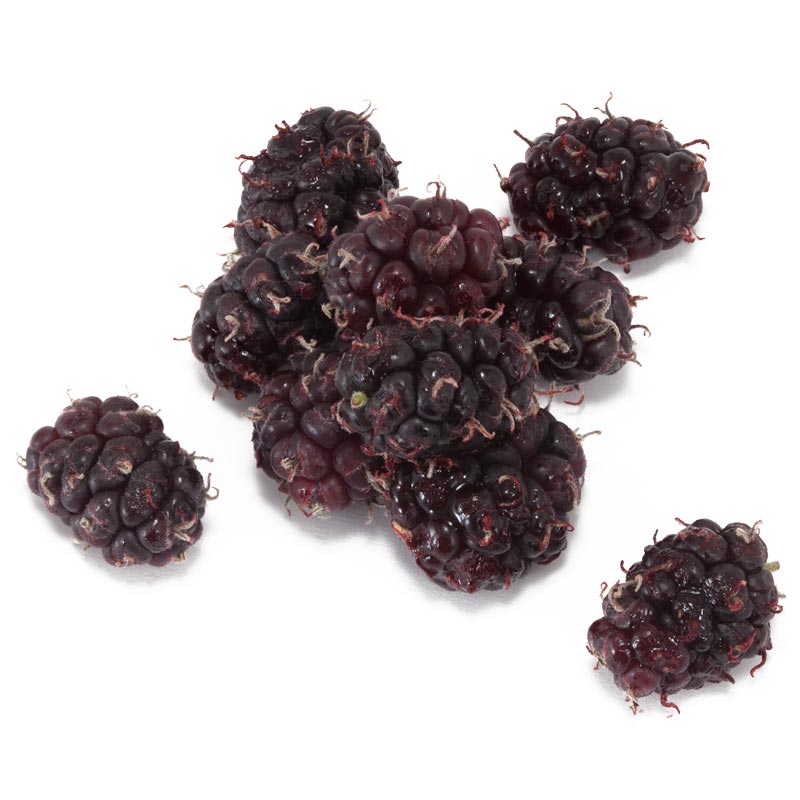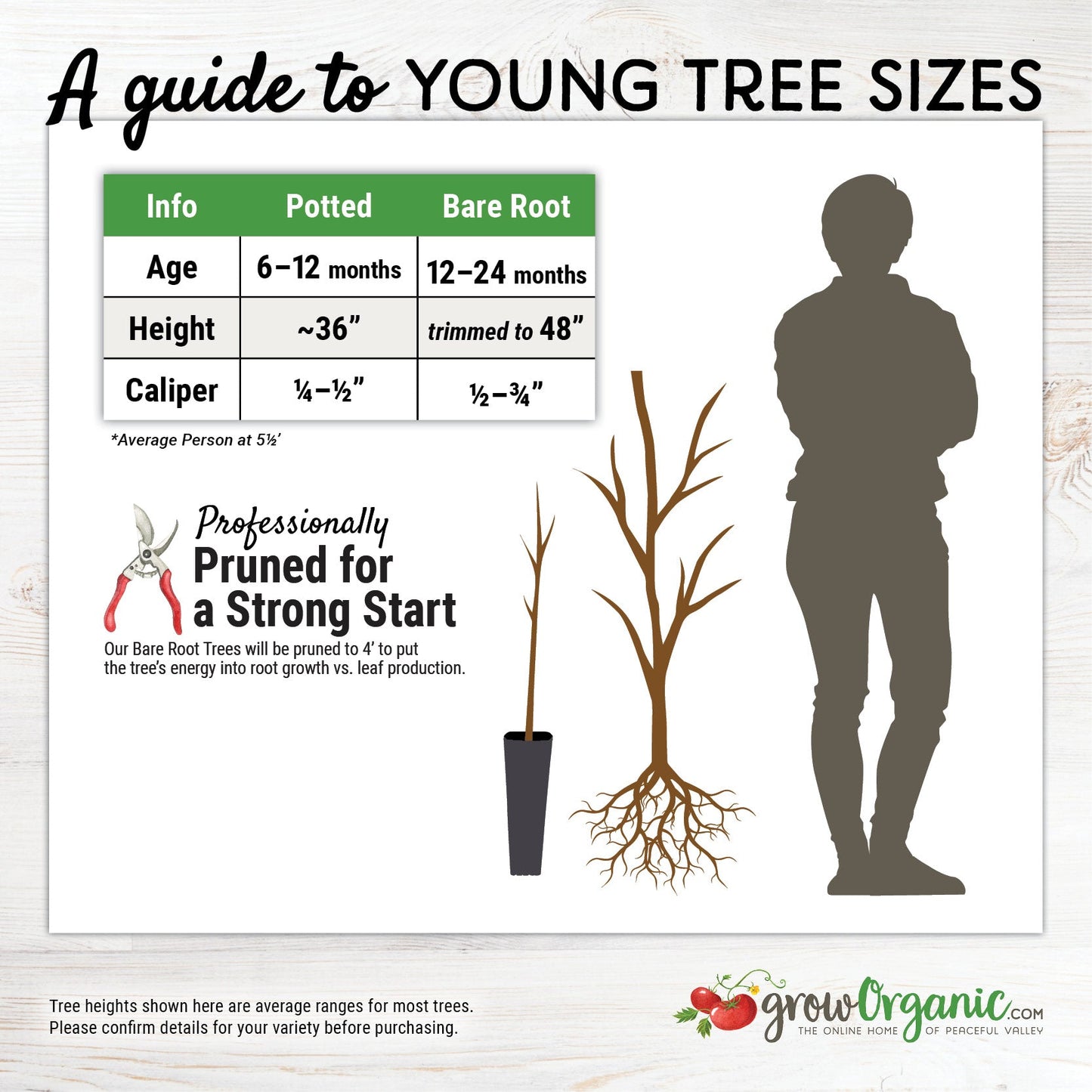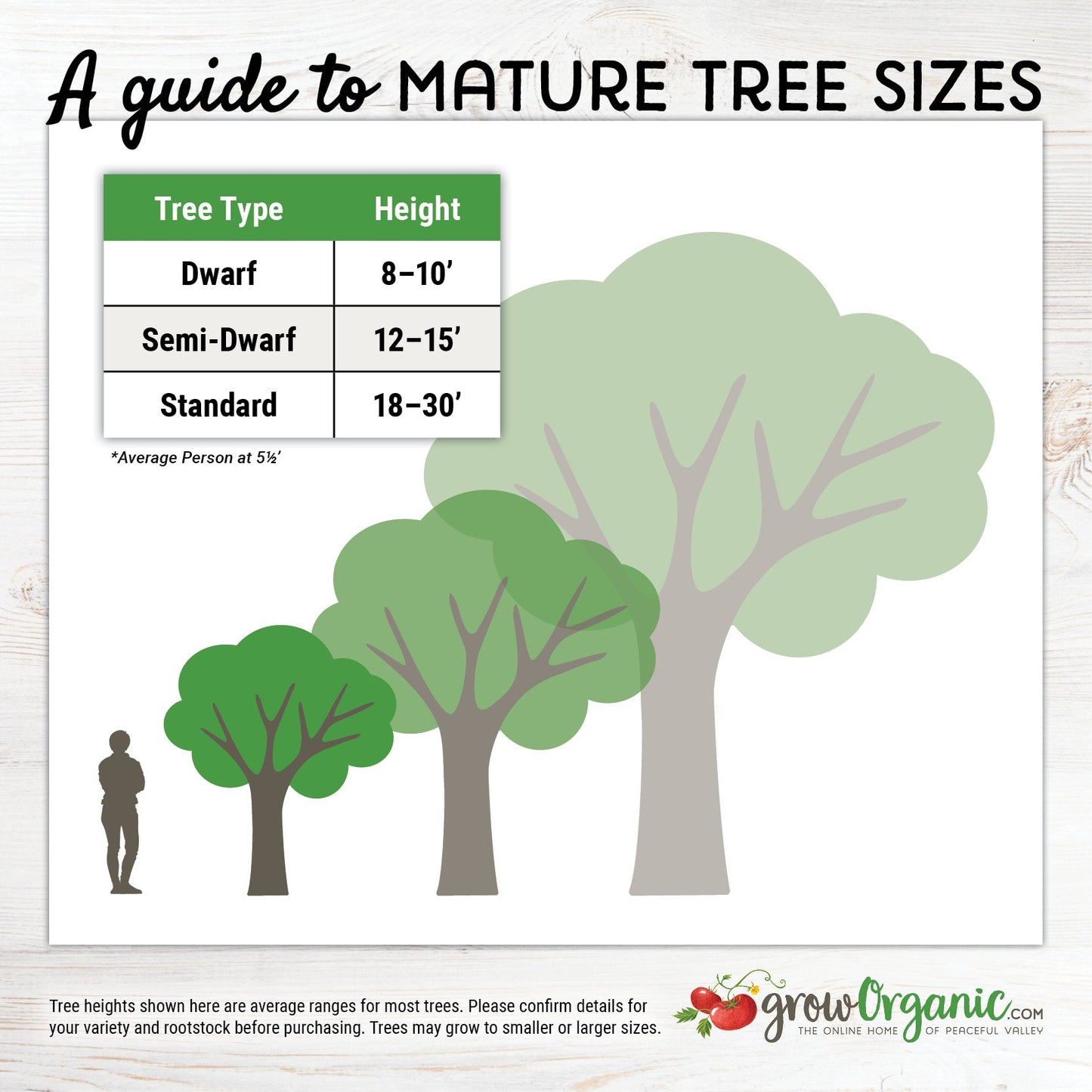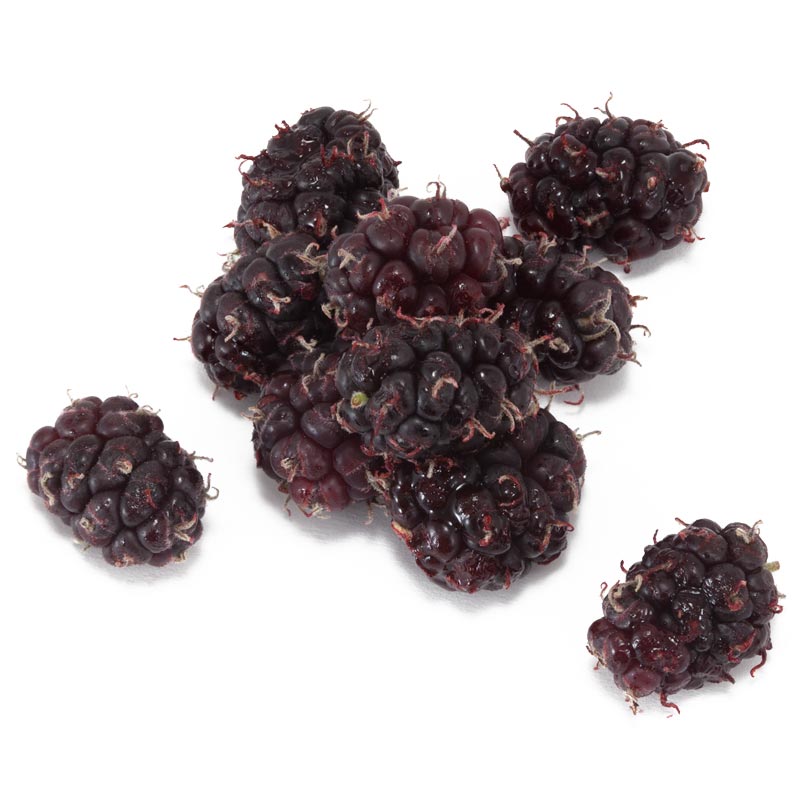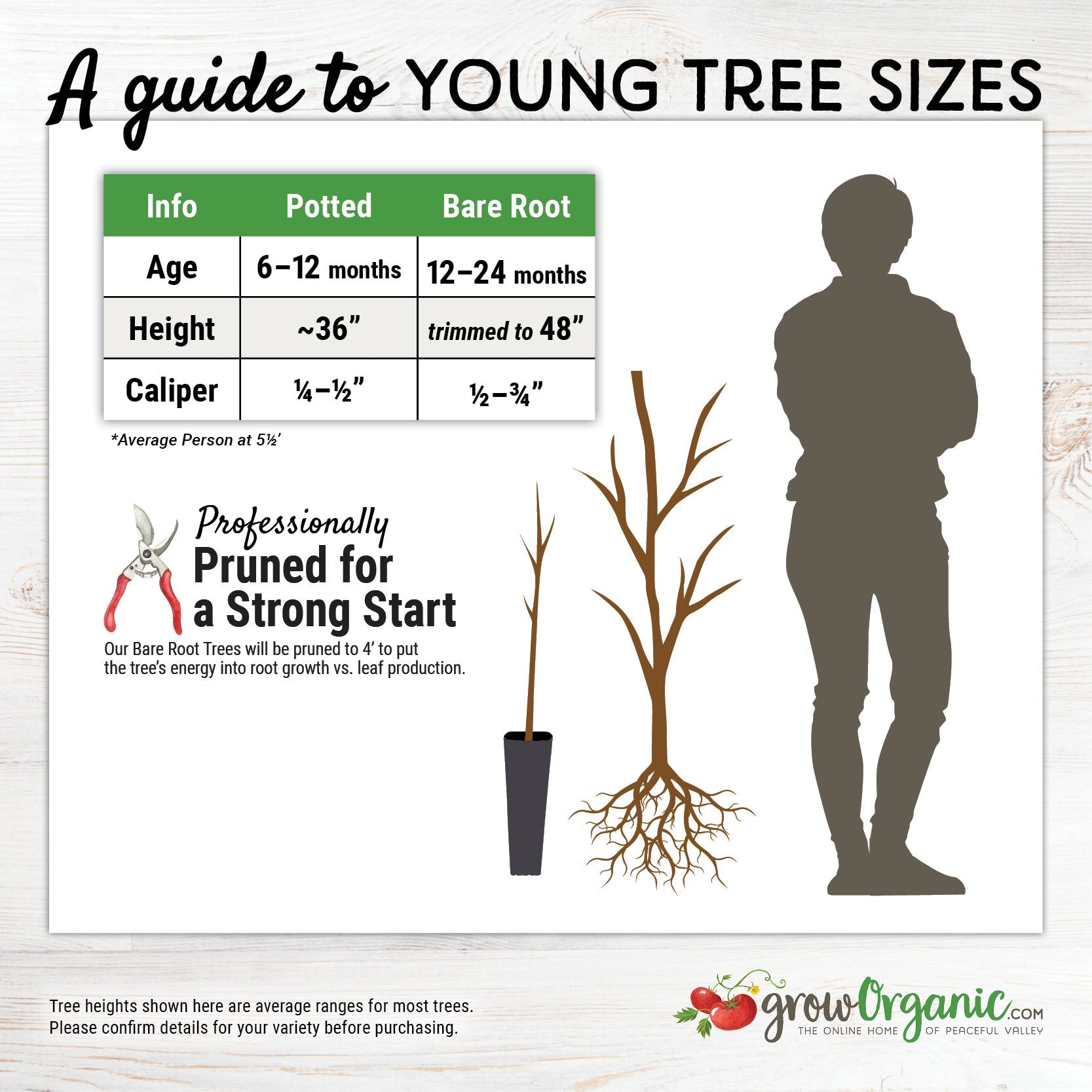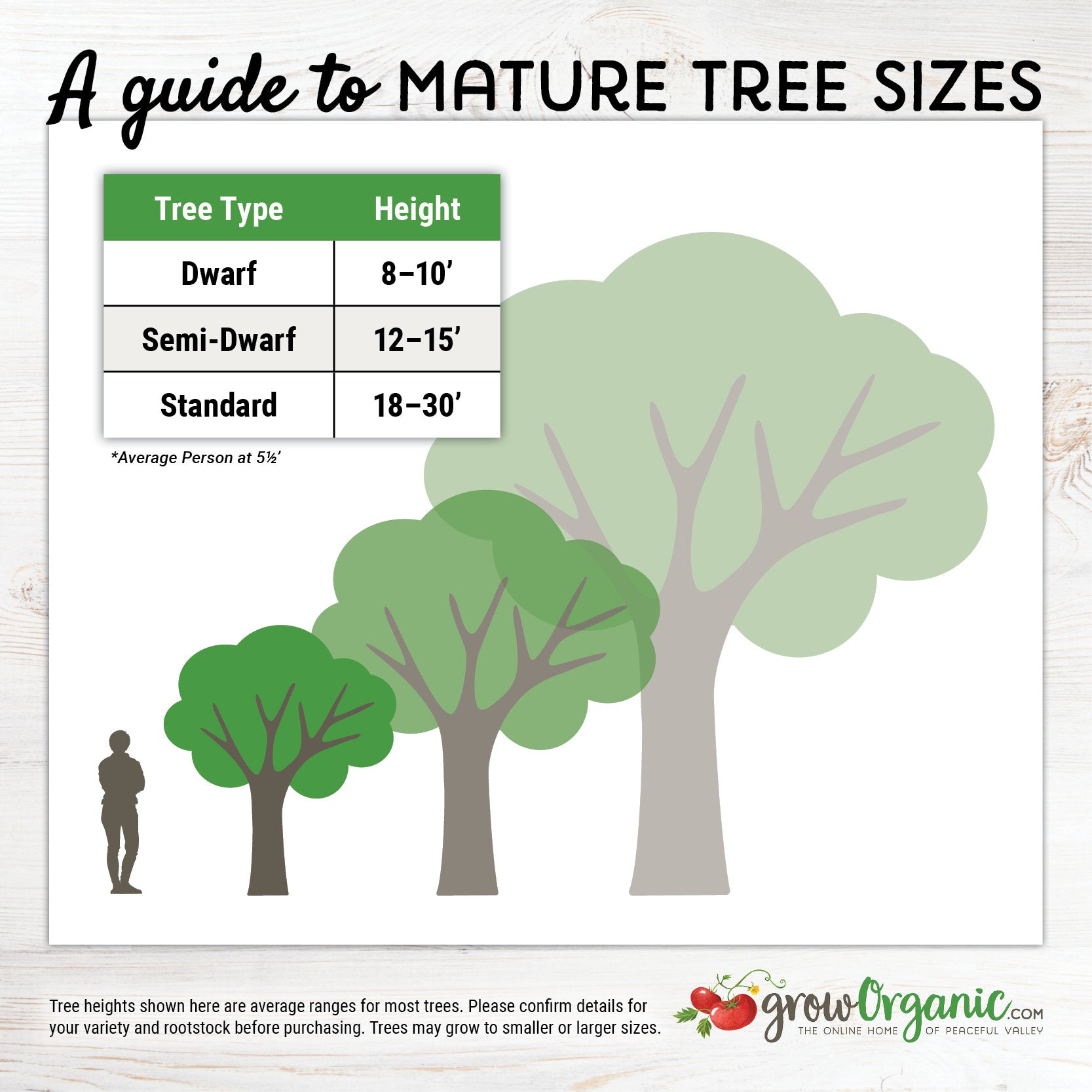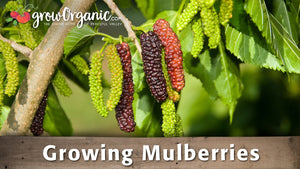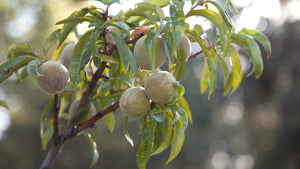Item Number: FT119
Persian Mulberry Tree
Persian Mulberry Tree
Drought Resistant and Vigorous
Standard on Russian Mulberry Rootstock
- Zones: 8-10
- Chill hours: 400
- Harvest: June 1 - July 1
- Looks: Bears large, black, tasty fruit similar to blackberries.
- Personality: The juicy fruit is excellent for jam, and boasts an appetizing berry-cherry flavor.
- Facts of note: Morus nigra Trained as a tree or as a shrub, it is densely foliated with large heart-shaped leaves; vigorous, easy to care for, and excellent for shade. The tree grows to between 25-30 ft and is fairly drought resistant once it has been established. Black mulberries are the favorite for wine making and drying.
- Pollination: Self-fruitful
The Persian Mulberry Tree (Morus nigra), celebrated for its succulent and versatile fruit, is a delightful addition to gardens and orchards. This deciduous tree, originating from the regions of Iran, bears the scientific name Morus nigra, distinguishing it from other mulberry species. Renowned for its luscious, dark-colored mulberries, this tree holds a cherished place among fruit enthusiasts and gardeners alike.
Characteristics of the Persian Mulberry Tree:
Distinctive Foliage: The Persian Mulberry Tree exhibits a vibrant display of heart-shaped, deep green leaves. Its foliage adds an appealing aesthetic to gardens and landscapes, providing a lush backdrop to the delicious fruit it produces.
Growth Habit: This deciduous tree typically reaches a height of 20 to 30 feet upon maturity, forming a rounded and slightly spreading canopy. Its growth habit makes it an excellent choice for shade, fruit production, or as an ornamental specimen.
Mulberry Fruit: The Persian Mulberry is renowned for its bountiful fruit production. The fruit, known as mulberries, is small to medium-sized and showcases a deep, rich color, ranging from dark purple to black. These sweet and juicy mulberries are prized for their exceptional flavor, making them suitable for fresh consumption, jams, jellies, desserts, and culinary creations.
Fruit Production: Persian Mulberry Trees typically yield fruit in early summer, delighting growers with an abundant harvest. The tree's fruiting potential adds a delectable dimension to gardens and orchards, enticing both human and avian admirers.
Cultivating Persian Mulberry Trees:
Cultivating a thriving Persian Mulberry Tree involves a few key considerations:
Location: Select a planting location that receives ample sunlight. Persian Mulberry Trees thrive in full sun, which promotes healthy growth and abundant fruit production.
Soil: These trees adapt well to various soil types, provided they offer good drainage. Loamy, well-drained soil is ideal for ensuring optimal root health.
Watering: Adequate moisture is essential during the tree's establishment phase. Once established, Persian Mulberry Trees are relatively drought-tolerant but benefit from consistent watering during dry spells.
Pruning: Regular pruning helps maintain the tree's shape, remove dead or diseased branches, and improve air circulation within the canopy. Pruning is typically performed during late winter or early spring.
Mulching: Apply a layer of organic mulch around the tree's base to conserve soil moisture, suppress weeds, and regulate soil temperature.
Persian Mulberries in Culinary Delights:
The mulberries produced by Persian Mulberry Trees are a gourmet delight. These sweet and succulent fruits can be enjoyed in a multitude of ways:
Fresh Consumption: Mulberries are a delicious snack when consumed fresh off the tree. Their sweet-tart flavor and juicy texture make them a refreshing treat on a warm summer day.
Jams and Jellies: Persian Mulberries are ideal for making homemade jams, jellies, and preserves. Their vibrant color and natural sweetness infuse these spreads with irresistible flavors.
Desserts: Incorporate mulberries into pies, tarts, crisps, and cobblers to add a fruity twist to your desserts. They pair beautifully with other fruits like strawberries and raspberries.
Smoothies: Blend mulberries with yogurt, honey, and other fruits to create delectable smoothies and shakes.
Mulberry Wine: For those with a penchant for winemaking, Persian Mulberries can be transformed into delightful homemade wines.
The Persian Mulberry Tree, with its exquisite fruit and ornamental value, offers a delightful fusion of beauty and bounty. Its adaptability, ease of cultivation, and delectable harvest make it a favored choice among home gardeners and fruit enthusiasts. Whether you're seeking a shade tree, a culinary delight, or a stunning addition to your landscape, the Persian Mulberry Tree stands as a testament to the joys of growing your own fruit.
Visit our Fruit Tree Central for a listing of all our fruit tree videos and articles.
Visit Tree Characteristics for a listing of all our fruit & nut tree growing characteristics.


Check Your Zone Compatibility:
Compatible with your zone.
Growing Zone for
,

Our Guarantee To You
Since 1976, we've served our customers at every stage of growing. Please contact us at any time. We are happy to support and assist you.
Description
Description
Standard on Russian Mulberry Rootstock
- Zones: 8-10
- Chill hours: 400
- Harvest: June 1 - July 1
- Looks: Bears large, black, tasty fruit similar to blackberries.
- Personality: The juicy fruit is excellent for jam, and boasts an appetizing berry-cherry flavor.
- Facts of note: Morus nigra Trained as a tree or as a shrub, it is densely foliated with large heart-shaped leaves; vigorous, easy to care for, and excellent for shade. The tree grows to between 25-30 ft and is fairly drought resistant once it has been established. Black mulberries are the favorite for wine making and drying.
- Pollination: Self-fruitful
The Persian Mulberry Tree (Morus nigra), celebrated for its succulent and versatile fruit, is a delightful addition to gardens and orchards. This deciduous tree, originating from the regions of Iran, bears the scientific name Morus nigra, distinguishing it from other mulberry species. Renowned for its luscious, dark-colored mulberries, this tree holds a cherished place among fruit enthusiasts and gardeners alike.
Characteristics of the Persian Mulberry Tree:
Distinctive Foliage: The Persian Mulberry Tree exhibits a vibrant display of heart-shaped, deep green leaves. Its foliage adds an appealing aesthetic to gardens and landscapes, providing a lush backdrop to the delicious fruit it produces.
Growth Habit: This deciduous tree typically reaches a height of 20 to 30 feet upon maturity, forming a rounded and slightly spreading canopy. Its growth habit makes it an excellent choice for shade, fruit production, or as an ornamental specimen.
Mulberry Fruit: The Persian Mulberry is renowned for its bountiful fruit production. The fruit, known as mulberries, is small to medium-sized and showcases a deep, rich color, ranging from dark purple to black. These sweet and juicy mulberries are prized for their exceptional flavor, making them suitable for fresh consumption, jams, jellies, desserts, and culinary creations.
Fruit Production: Persian Mulberry Trees typically yield fruit in early summer, delighting growers with an abundant harvest. The tree's fruiting potential adds a delectable dimension to gardens and orchards, enticing both human and avian admirers.
Cultivating Persian Mulberry Trees:
Cultivating a thriving Persian Mulberry Tree involves a few key considerations:
Location: Select a planting location that receives ample sunlight. Persian Mulberry Trees thrive in full sun, which promotes healthy growth and abundant fruit production.
Soil: These trees adapt well to various soil types, provided they offer good drainage. Loamy, well-drained soil is ideal for ensuring optimal root health.
Watering: Adequate moisture is essential during the tree's establishment phase. Once established, Persian Mulberry Trees are relatively drought-tolerant but benefit from consistent watering during dry spells.
Pruning: Regular pruning helps maintain the tree's shape, remove dead or diseased branches, and improve air circulation within the canopy. Pruning is typically performed during late winter or early spring.
Mulching: Apply a layer of organic mulch around the tree's base to conserve soil moisture, suppress weeds, and regulate soil temperature.
Persian Mulberries in Culinary Delights:
The mulberries produced by Persian Mulberry Trees are a gourmet delight. These sweet and succulent fruits can be enjoyed in a multitude of ways:
Fresh Consumption: Mulberries are a delicious snack when consumed fresh off the tree. Their sweet-tart flavor and juicy texture make them a refreshing treat on a warm summer day.
Jams and Jellies: Persian Mulberries are ideal for making homemade jams, jellies, and preserves. Their vibrant color and natural sweetness infuse these spreads with irresistible flavors.
Desserts: Incorporate mulberries into pies, tarts, crisps, and cobblers to add a fruity twist to your desserts. They pair beautifully with other fruits like strawberries and raspberries.
Smoothies: Blend mulberries with yogurt, honey, and other fruits to create delectable smoothies and shakes.
Mulberry Wine: For those with a penchant for winemaking, Persian Mulberries can be transformed into delightful homemade wines.
The Persian Mulberry Tree, with its exquisite fruit and ornamental value, offers a delightful fusion of beauty and bounty. Its adaptability, ease of cultivation, and delectable harvest make it a favored choice among home gardeners and fruit enthusiasts. Whether you're seeking a shade tree, a culinary delight, or a stunning addition to your landscape, the Persian Mulberry Tree stands as a testament to the joys of growing your own fruit.
Visit our Fruit Tree Central for a listing of all our fruit tree videos and articles.
Visit Tree Characteristics for a listing of all our fruit & nut tree growing characteristics.
Mulberry trees are native to tropical climates and produce a sweet multiple-fruit (looks somewhat like a long skinny blackberry). The trees grow swiftly at first but soon become slow growing, a mature tree rarely reaches over 30 ft. Black mulberries can grow in a bushy-like habit if not trained young into a tree. The fruit is used extensively in jams. The trees are fairly drought tolerant once established. Trees are 2 years old and should fruit in their 3rd year. Browse all our mulberry trees for sale.
Mulberries are generally free of pests and diseases, although cankers and dieback can occur. They like a warm, well-drained soil, preferably a deep loam. Shallow soils such as those frequently found on chalk or gravel are not recommended. Mulberries are prone to desiccation and frost damage when planted from bare root. To reduce the risk of plant loss it is a good idea to thoroughly hydrate the plant and prune back the lateral growth of the plant to reduce the amount of surface area exposure.
Russian Mulberry Rootstock: a tough, drought resistant and hardy rootstock for mulberries.
Please Note: Although most of our bare-root trees arrive to our warehouse in mid-December, there are a few varieties that will not arrive until mid-January. If you order any of those varieties along with varieties that arrive in mid-December, your order will be delayed for shipment until mid-January. If you'd like us to split your shipments, please contact us at (888) 784-1722 or orderdesk@groworganic.com. Additional shipping charges will apply.
Shipping Information
Shipping Information
Cannot ship to the following states: HI, AK, PR, GU, VI
Cannot ship via USPS.
Cannot ship via SmartPost.
Shipping Weight: 5.0 lb
Dimensions: 55.5"L x 7.3"W x 2.75"H
Features
Features
- Self-fruitful
Characteristics
Characteristics
Planting & Care
Planting & Care
Mulberries are generally free of pests and diseases, although cankers and dieback can occur. They like a warm, well-drained soil, preferably a deep loam. Shallow soils such as those frequently found on chalk or gravel are not recommended. Mulberries are prone to desiccation and frost damage when planted from bare root. To reduce the risk of plant loss it is a good idea to thoroughly hydrate the plant and prune back the lateral growth of the plant to reduce the amount of surface area exposure.
Useful Information
Useful Information
Guarantee
Guarantee
Limited Dormant Tree & Plant Guarantee
* Claim deadline is June 15th
We guarantee that your dormant tree or plant will arrive in good, viable condition. If your tree arrives in substandard condition, notify us within 3 days of delivery. Please email pictures of the box, inside packaging, the tree and its roots to helpdesk@groworganic.com. We will investigate your claim and process a request to exchange or refund the damaged product.
If your dormant tree or plant has not grown new leaves by June 15th, you may be eligible for our Limited Dormant Tree & Plant Guarantee. This guarantee provides for a store credit for the purchase price of the tree, excluding shipping. Please see the Instructions below.
Important Dates:
- April 1st Dormant trees/plants must be planted in the ground
- May 15th Perform scratch test, if no new leaves have grown
- June 15th Deadline to apply for a dormant tree/plant credit
All required documentation must be received by June 15th for your claim to be considered. Claims or documentation received after June 15th will be denied, without exception. Instructions listed below
Terms and Conditions
We cannot guarantee that your tree or plant will remain alive and healthy after it is received, or bear fruit as there are too many variables in your environment that are beyond our control (i.e. soil preparation, weed and pest control, proper irrigation, chill hours, compatible hardiness for your growing zone, proper choice of pollinator, extreme weather, rodent damage, disease, etc.).
We cannot guarantee that we will be able to provide a replacement tree/plant of the same species either that same growing season or in future years. Customers are responsible for all shipping fees associated with replacement trees and plants.
If we determine that the tree you purchased directly from us is not viable, we will issue you a store credit (not a refund) for the purchase price of the affected dormant tree or plant. Shipping is not included in the dormant tree/plant guarantee. Store credits can be used to purchase any product we sell and are valid for use only until July 1st of the following year.
Historically, 98% of our dormant trees and plants grow and thrive when they have been cared for and planted using our growing guides. Dormant trees and plants must be planted in the ground by April 1st in order to be eligible for credit. If the ground in your area is still frozen solid, you may temporarily plant your tree or plant in a pot.
Potted, non-dormant trees or plants are excluded from this guarantee as they are not dormant at the time of shipment. Evergreen trees such as citrus, avocado and olive trees are not available for credit under the Dormant Tree and Plant Guarantee.
Instructions
We guarantee that your dormant fruit tree or plant will leaf out, if you care for it according to our growing guides. In the unlikely event that your dormant tree or plant does not have leaves by May 15th, follow these simple steps to apply for a store credit:
Before you call or email, please perform a “scratch test” to determine if the tree or plant is still alive. This video shows how to check for live tissue under the bark. Scratch tests need to be done a few inches above and below the graft.
Green Cambium Layer / Living Trees
If the cambium layer under the bark is green, give your tree a little more time. It is still alive, but hasn’t come out of dormancy yet. Check to make sure that it is getting the right amount of deep root water, enough sunlight and that the weather is warm enough for that type of tree/plant to come out of dormancy. Every tree has its own personality and will come out of dormancy at different times. Be sure to submit the required documentation listed below by June 15th, if it doesn’t grow leaves.
Brown Cambium Layer / Dead Trees
If the scratch test shows a brown cambium layer or if your dormant tree/plant doesn’t have leaves by June 1st, please email us at helpdesk@groworganic.com. All required documentation listed below must be received by June 15th for your claim to be considered. To be considered for the guarantee claim, all required documentation must be received by June 15th. Incomplete submissions will be denied.
Required Documentation
- Order number
- Name of dormant tree/plant and the quantity affected
- Photos of each tree or plant showing:
- The roots (tree or plant must be pulled out of the ground)
- The scratch test areas
- The entire tree/plant
We reserve the right to not issue credit for items that have already been replaced. We also reserve the right to require photographic evidence that the tree/plant was not killed by root rot, rodent or mechanical damage.
Share
